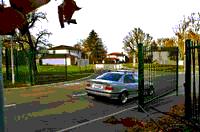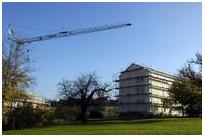Germany's slippery slopes make for
super sledding
By Charlie Coon, Stars and Stripes
European edition, Saturday, December 31, 2005
STUTTGART, Germany - The Friday before New Year's weekend. A day off for most of the military. A perfect day for sledding.
"It's fast and it's fun, especially that jump up there," said 13-year-old Tyler Vaughn. "I went like about 4 feet. It felt like it, anyway."
Conditions were ideal for sledding at Robinson Barracks in Stuttgart. There was a lot of fresh snow, it was cold enough to keep it powdery, but sunny enough to stay warm.
About 75 people were frolicking on the hill, which was about 150 yards long. Two dogs Rika, a 5-month-old Hungarian Vizsla, and Petra, an 11-month-old Springer spaniel were running down the hill after the sledders.
The hill was steep enough to pick up good speed but not too steep or too long, which made walking back up a little easier. The half-bowl shape offers a lot of different ways down. Parts of the hill had matted-down snow, which was good for the saucers, flat plastic sleds and inner-tubes. Parts were a little deeper, which worked well for the taller German-made sleds with two runners.
"On the powder they go great because they've got the high ground clearance," said Air Force Lt. Col. Brian Norman.
There was even a sled with a baby seat.
The key to good sledding: Let gravity do the work. "Don't try to steer, unless you're going to hit somebody," said 14-year-old Scott Norman. "When you try to steer, you start wobbling back and forth and then you flip over."

STUTTGART, Germany - For years, everyone has been able to travel on a public road through Robinson Barracks and past unguarded U.S. military housing. But because of a recent order to tighten security at U.S. bases, Stuttgart military officials are negotiating with the city on ways to relocate about 200 unguarded Americans or, as a last resort, close the busy public road.
The road Roter Stich Strasse has gates at either end that could be closed at any time, thus sealing off the Americans from anyone outside of Robinson Barracks and satisfying the new security desires. But the street is a busy thoroughfare that the city wants to keep open. Stuttgart military leaders said they do not want the road closed, but would do what is necessary to protect the Americans who live on it. "U.S. Army Garrison Stuttgart has the capability to secure Robinson Barracks at the appropriate threat level," Jennifer Sanders, a garrison spokeswoman, said in an e-mailed response to questions. "The current fencing allows the USAG-Stuttgart the option of securing the installation entirely including Roter Stich Strasse. Any increase in the threat level and measures will be coordinated with the city of Stuttgart to ensure that our actions have minimal impact on our German neighbors."
About 2,000 Americans live on Robinson Barracks, but only about 200 live along Roter Stich Strasse, according to German media reports. An 8-foot-high, green steel fence surrounds the rest of the property.
Stuttgart city officials said they wish to buy the unsecured parcel from the German government, which owns the land, in order to keep the mile-long road open. But who pays for what, and when a transaction could take place, was being negotiated.
"That is part of what we are figuring out right now," said Stephan Schorn, a spokesman for the Stuttgart mayor's office. "[Also], if [the displaced Americans] need [new] houses at all, how many, and which size? All those things are not decided yet. "We are seeing the problems from the American military that they are not able to control all the entrances if [residences] are on both sides of the street. On the other side, we definitely want to keep the street open as long as possible. Therefore, we want to help the American military to find a better way to control their entrances." Schorn declined to comment on whether the Americans might decide to close the gates, and thus close the road to public traffic, if a deal can't be worked out. "We as a city always think our aim is to find solutions which both sides can live with," Schorn said. "So we don't really discuss this question yet."
Robinson Barracks, one of four U.S. bases around the city, sits on about 170 acres of scenic hilltop in the north section of the city. The barracks has a combination exchange and commissary, elementary school and movie theater that, along with most of the housing, cannot be accessed without driving through a security gate or breaching the fence. The talks between the city and U.S. officials began after a September order given by U.S. European Commander Marine Gen. James L. Jones that required U.S. military communities in Europe to address and, if possible, fix security vulnerabilities.
Jones' order came one month after three anti-war protesters, including a 70-year-old woman, turned themselves in to police after they cut a large hole in the fence at Patch Barracks, where EUCOM headquarters is located, walked onto the base and hung a banner. They then walked unchallenged from one end of the base to the other and out the main security gate, where they turned themselves in.
Public road runs right through
debate on security at Stuttgart
Robinson Barracks debates closing gates on busy Roter Stich Strasse
By Charlie Coon, Stars and Stripes
European edition, Sunday, November 13, 2005

Charlie Coon / S&S
The eight-foot high steel fence that surrounds Robinson Barracks has gates that could close off Roter Stich Strasse, a busy thoroughfare in Stuttgart, Germany. Military officials, however, are working with the city to find an alternate answer that will increase base security but allow the street to remain open.
Robinson Barracks gets
makeover for AFRICOM
New command rejuvenating once-flagging Stuttgart post
By John Vandiver, Stars and Stripes
European edition, Monday, October 27, 2008
STUTTGART, Germany — Not long ago, the little bedroom community perched above Stuttgart was on its way to becoming a relic. With just a small group of families calling Robinson Barracks home and all of the U.S. military’s business being conducted at posts on the other side of town, the community was on the brink of being mothballed. But things can change fast in the military, and now this picturesque village is starting to bustle.
"There’s a lot being planned right now. It’s a community that’s growing," said Larry Reilly, a spokesman for the U.S. Army Garrison, Stuttgart. The re-emergence of Robinson coincides with the advent of U.S. Africa Command, which is headquartered in Stuttgart. With a new command came the need for more housing. Now, blocks of housing units are cordoned off at Robinson as construction crews work on a $42 million project to renovate 20 stairwells. Work is scheduled to be completed around next August, according to garrison officials. Currently there are 175 families who call Robinson home. About another 100 families will be added when the renovations are finished. The rapid growth means that more quality of life resources also will be needed in the community. "When you have a lot of people come in it does challenge all your assets," he said. "Robinson is not being neglected. It’s being looked at in the broader picture," Reilly said.
Situated to the north of Stuttgart, residents at Robinson are somewhat isolated from the military community’s main population hubs to the south, where U.S. European Command, AFRICOM, and garrison headquarters are spread out between three posts. If the traffic is bad, the commute can take up to 45 minutes to get from Robinson to the other locations. With most major services on the south side of town, garrison officials are looking for ways to bolster services in the north, Reilly said.
Certain things will not be feasible, such as setting up a full service Army Community Service office or child care center. But smaller satellite offices offering training programs and classes are being looked at, Reilly said.
Meanwhile, Robinson’s lone restaurant — the Sunset Bar and Grill — will be renovated and replaced with a yet-to-be named food service provider. Other services such as an outdoor recreation office could be added to the entertainment center grounds.
In the months ahead, surveys will be conducted to gauge what types of food contractors would fit with the community’s needs, Reilly said. "If we can cater to their desires, then the more likely they’ll be to use what’s put there," he said.
The housing renovations at Robinson come on the heels of a similar effort at Kelley Barracks, where all the apartments on post were recently renovated. Earlier this year, the U.S. Army Corps of Engineer project manager described the type of work being done at Kelley and Robinson.
"Everything’s been modernized," said John Gerlach, the Corps’ resident engineer for Stuttgart. "It’s beautiful. There are all new ceramic tiles; the plumbing fixtures and the bathrooms are gorgeous."

John Vandiver / S&S
Housing is being modernized at Robinson Barracks in Stuttgart, Germany. The $42 million project is intended to serve a wave of families coming in as U.S. Africa Command becomes established.
Robinson Barracks theater closing due to low attendance
Stars and Stripes
European edition, Friday, September 29, 2006
The theater at Robinson Barracks in Stuttgart, Germany, will close after Saturday due to low attendance, according to Hugh McBride, a spokesman for Army Garrison Stuttgart.
Robinson Barracks is a housing area on the north side of the city. On Oct. 6, the community club at Robinson Barracks will begin showing recently released movies for free Wednesdays through Sundays.
The movie theater and community club are operated by the garrison’s directorate of Morale, Welfare and Recreation.
First-run movies will continue to be shown at Patch Theater on Patch Barracks, which reopened in December after a $3.2 million renovation.